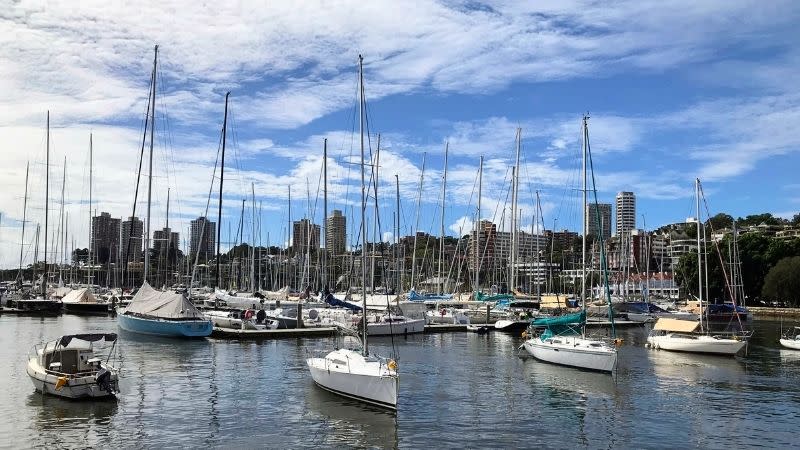
The Urban Developer’s latest Sydney housing market insights reveal the city’s home values have clawed back lost ground but still sit 11.2 per cent below their record high set in January 2022….
This resource, updated periodically, will collate and examine the economic levers pushing and pulling Sydney’s housing market.
Combining market research, rolling indices, and expert market opinion, this evolving hub will act as a pulse check for those wanting to take a closer look at the movements across the market.
Sydney median property prices % change
| Type | Month | Quarter | Annual | Median |
|---|---|---|---|---|
| All | 1.3% | 3% | -10.7% | $1,031,138 |
| Houses | 1.3% | 3.2% | -12% | $1,253,759 |
| Units | 1.2% | 2.3% | -7.2% | $787,427 |
^Source: Corelogic - April 2023
Sydney home prices rebounded 1.3 per cent in April, 2023, giving home values in the NSW capital a 3 per cent boost for the quarter, CoreLogic reported.
This shaved the drop in Sydney home prices to 10.7 per cent for the year, and put them 11.2 per cent below than their record high set in January, 2022, CoreLogic data showed.
Nationally, meanwhile, home values rose 1 per cent in the three months to April, which was the first quarterly lift in Australian home values since May 2022.
Home values in Australia were 8 per cent lower over the 12 months, leaving the annual decline steady on the 12 months to March.
The combined capital cities dwelling market value rose 0.7 per cent in April, after a 0.8 per cent lift in March. This took home prices 1.4 per cent higher from a trough in February this year, CoreLogic found.
Sales
In Sydney, home sales dropped 29.1 per cent for the year to April 2023, greater than the combined capitals drop-off of 20.8 per cent.
Nationally, sales showed a seasonal decline, with an estimated 35,398 sales reported by CoreLogic. Despite this decrease, the sales volume is in line with typical seasonal patterns. Compared to the previous year, sales sank 21.5 per cent, although this easing is from a period of particularly strong selling.
Time to sell
The median days on the market for selling property in Australia had improved. In the three months to April, the national median days on market dropped to 33 days, compared with 37 days in the three months to February.
In the three months to April 2022, however, it was 23 days.
Sydney recorded 33 median days on market for the quarter to April 2023, up from 26 in the previous corresponding period.
Discounts
In Sydney, the home vendor discount inflated from 3.4 per cent for the April quarter last year, to 4.1 per cent for the three months to April 2023, CoreLogic reported.
The median vendor discount in the combined capital cities market has decreased, indicating that vendors are now offering smaller discounts on their properties. It has eased from a 4.35 per cent deduction in the September quarter of 2022 to a 3.88 per cent discount in the three months to April 2023.
Listings
In the four weeks to May 7, 2023, the national volume of new listings hit 31,356.
Although there has been an uptick in new listings after a series of public holidays, it is expected they will dip seasonally during the cooler months.
There were 137,629 listings observed nationally during the same period.
However, the total number of listings remains significantly lower than the five-year average due to fewer new selling decisions being made, CoreLogic said.
Compared to the same period last year, new listings advertised were lower across all regions, while the balance of total listings varied. In Hobart, Canberra, and some regional markets, total listings were higher compared to May 2022.
In Sydney, new listings were down 18.4 per cent. Nationally, the retreat was 21 per cent, and combined capitals were 20.6 per cent down.

>> Brisbane Housing Market Insights
>> Melbourne Housing Market Insights
Sydney’s housing market: policy updates and trends
NSW boosts first home buyer concessions
NSW will modify stamp duty thresholds to help more first-time home buyers, TheGuardian.com reported. The impending legislation will raise concession thresholds, resulting in five in six new buyers paying less or no stamp duty. The first home buyers assistance scheme will now exempt properties worth up to $800,000, a rise from $650,000, and concessions will be applicable to properties up to $1m. These reforms will allow 84 per cent of first home buyers to pay a reduced or no stamp duty.
NSW pushes for high-rise quality amid challenges
NSW planning authorities are calling for an improvement in the quality of high-rise residential developments to regain buyer confidence after years of poor-quality constructions. These issues came under scrutiny following the evacuations of the Mascot and Opal Towers in 2018 and 2019, leading to the launch of Project Intervene by NSW Building Commissioner David Chandler, which aims to rectify serious defects through NSW Fair Trading. However, numerous building rectification orders and investigations during the past year suggest a long road ahead.
Cities need density and infrastructure boost
Australian cities’ liveability was declining due to affordability, cost of living, and traffic congestion, urbanist Professor Greg Clark said. He emphasises the need for local governments to encourage housing supply diversity and urban density. To future-proof cities, a more rapid investment in infrastructure, a pro-density approach, and a focus on climate resilience were crucial.
What the experts are saying about Sydney’s housing market

Tim Lawless
Head of Research
Corelogic
“At the moment it looks like high demand from net overseas migration and a spill-over of demand from tight rental markets would help to offset the impact of higher rates, but probably not completely.
“Higher interest rates would likely push consumer sentiment lower, from already very low levels. We know that consumer sentiment and housing market activity show a close relationship, so a further drop in consumer attitudes would likely quell the recent evidence of higher sales.
“We could also see a reduction from domestic demand as prospective buyers find it harder to obtain credit amid stringent servicing assessments and a cautious lending sector.”

Shane Oliver
Chief Economist
AMP Capital
“Given the resurgence in underlying demand on the back of very high immigration levels and constrained supply we have revised up our home price forecasts—which is not something I feel entirely comfortable with (given the risks from higher interest rates) or like (given horrible housing affordability).
“Our base case is now for flat to slightly up prices this year followed by a 5 per cent rise next year. Sydney (benefitting from the surge in immigration) and Perth (with better affordability) are likely to lead the way.”

Nicola Powell
Chief of Research and Economics
Domain
“The top end of the market has bounced back strongly in the past six months despite five back-to-back rate increases during that period, which means buyers were not put off by rate rises.
“There’s a distinct lack of listings, so buyers are forced to compete for fewer homes on the market, which is helping support prices.
“I think there’s enough momentum in this segment to keep rising despite higher interest rates.”

Louis Christopher
Managing director
SQM Research
“Overall, building approvals are very concerning.
“I’m not sure how Labor can be that confident that they’re going to achieve their goal of a million dwellings being completed by 2029.
“The government needs to manage migration numbers. New home building catering for that population expansion will not be there. This has significant ramifications for the ongoing rental crisis.
“So, despite the rise in interest rates, given the increase in underlying demand relative to supply, it’s likely we will see housing prices rise over the medium term.”
Sydney auction clearance rates
| Week | Clearance rate | Total Auctions |
|---|---|---|
| Week ending 1 April 2023 | 69% | 704 |
| Week ending 15 April 2023 | 74% | 495 |
| Week ending 22 April 2023 | 66% | 396 |
| Week ending 29 April 2023 | 68% | 401 |
^Source: Domain - April 2023
Sydney outperformed the other capitals in April, marking its third straight auction clearance rate increase, Domain reported.
This is the highest since October 2021. Its annual rate also jumped by 9.3 points—the largest among capital cities.
As for auction volumes, Sydney was down 34.5 per cent inline with a national softening (bar Adelaide) but lower auction volumes were expected due to public holidays in April, Domain said.
The most auction-centric cities, Sydney and Melbourne, had clearance rates higher than at the same time last year.
The combined capitals recorded a boost in clearance rates, reaching a 14-month high at 66 per cent, while the combined regionals rose to a 13-month high at 49.6 per cent. This represented the first annual increase in clearance rates in 15 months for the combined capitals and 16 months for the combined regionals.
Canberra was the only capital to record a drop in its monthly clearance rate and notched a substantial annual downturn as well.
For the combined capitals, this month broke the recent trend of increasing unit clearance rates, with houses now taking the upper hand.
Sydney residential rental vacancy rate
| City | Vacancy rate | Monthly change | Vacancies | Net change |
|---|---|---|---|---|
| Sydney | 1.3% | -0.9% | 9301 | 85 |
^Source: SQM Research - Febrary 2023. Monthly change based on vacancies and net change.
Sydney’s vacancy rate climbed to 1 per cent in April, marking its first increase since December. This shift resulted from a monthly uptick in rental stock. Despite the increase, the rate remained at an April all-time low and is tracking 29.8 per cent lower year-on-year, Domain reported.
Australia’s overall vacancy rate held steady at a record low of 0.8 per cent in April, pointing towards a stabilised market despite ongoing challenges for tenants.
The rates in Melbourne, Adelaide, Hobart, and Canberra all increased in April, with rates of 0.9 per cent, 0.4 per cent, 1.1 , and 1.7 per cent respectively. Brisbane, Perth, the combined capitals, and the combined regionals, on the other hand, maintained a stable vacancy rate. In contrast, Darwin was the only city to witness a drop in its vacancy rate, lowering it to 0.7 per cent, slightly off its record low from June 2022.
While Perth and Adelaide proved to be the most competitive for tenants, holding at 0.4 per cent, Brisbane showed signs of moving away from intense competition, maintaining a steady rate of 0.7 per cent.
Notably, despite the historically low vacancy rates, rental listings are on an upswing, hitting their highest point this year. However, this rise is largely due to a decrease in listings in the two largest capitals, Sydney and Melbourne, indicating that the market still heavily favors landlords.
If current trends continue, the increase or stabilisation of vacancy rates in most cities could herald a broader shift in the rental market. As more cities recorded improvements in rental listings, it might bring balance to a market long dominated by landlords, Domain said.
Sydney rent prices
| Type | Rent | Monthly % change | Annual % change |
|---|---|---|---|
| Houses | $963.71 | 0.8%▲ | 20.9%▲ |
| Units | $658.27 | 0.1%▼ | 28.4%▲ |
^Source: SQM Research - to May 20, 2023
Sydney’s rental market surged in April due to an influx of overseas migrants and students and a shortage of rental listings. The city reported a 1.3 per cent hike in home rental values, reflecting a broader trend that has driven a record annual rental increase in Australia’s capitals.
CoreLogic’s data shows an 0.8 per cent rise in national home rentals for April. The combined capitals set a record with an 11.7 per cent annual rental jump, largely driven by demand for city units.
Sydney’s unit rents alone rose by 5.8 per cent in the quarter, and 19.1 per cent year-on-year in April.
While regional markets show signs of slowing, city unit rents still outpace house rents due to high demand from migrants and international students.
Given the ongoing migration influx and low rental supply, the outlook for tenants seeking short-term relief is dim, and supply issues are expected to persist in the long run, CoreLogic said.
NSW building approvals
| Dwelling | Approved | Monthly % change |
|---|---|---|
| Houses | 1877 | -4.0% |
| All dwellings | 3114 | 3.1% |
^Source: Australian Bureau of Statistics - March 2023
In New South Wales, total home approvals chalked up a 3.1 per cent increase, despite a 4 per cent fall in approvals for private sector houses, the latest Australian Bureau of Statistics showed.
Approvals surged 27.2 per cent in Western Australia, which was also the only state to report a rise in private sector house approvals at 8.7 per cent. Victoria too managed a modest rise in total home approvals of 1.7 per cent, although private sector house approvals fell 3.8 per cent.
Seasonally adjusted total home approvals recorded downturns in Tasmania, falling sharply by 42.1 per cent, South Australia at 19.1 per cent, and Queensland at 6.7 per cent. These states, alongside NSW, Victoria, and South Australia also experienced declines in approvals for private sector houses, with reductions of 3.9 per cent, 0.1 per cent, and 3.8 per cent respectively.
Nationally, the total homes approved fell 0.1 per cent in March, in seasonally adjusted terms, following a 3.9 per cent rise in February, the ABS reported.
ABS head of construction statistics Daniel Rossi said: “The result was driven by a 2.8 per cent fall in approvals for private sector houses, following an 11.3 per cent February rise. Private sector house approvals remain 15.0 per cent lower than March 2022.
“Private sector dwellings excluding house approvals increased 5.6 per cent in March, following a 9.7 per cent decrease in February.
“This is the sixth consecutive month where the trend result has fallen for total dwellings approved,” Rossi said.
NSW home loan lending indicators
| Type | Lending ($bn) | Monthly % change |
|---|---|---|
| New loan commitments for owner occupier housing | $4.412 | -7.1% |
| New loan commitments for investor housing | $2.857 | -0.7% |
^Source: Australian Bureau of Statistics - January 2023
The value of new loan commitments for owner-occupier housing fell 7.1 per cent in NSW in January, the latest Australian Bureau of Statistics figures show.
The total came in at $4.412 billion, down from $4.752 billion in December and $7.369 billion in the previous January.
They peaked in July 2021 at $7.781.
Loan commitments for NSW investors fell 0.7 per cent to $2.857 billion in January from the prior month’s $2.877 billion. The result was a big drop on the January 2022 result of of $4.454 billion, which was the peak.
The average loan size for NSW owner-occupiers was $767,019 in January compared with a national average of $601,252, and down from the peak in January 2022 of $803,235.
Meanwhile, the number new loan commitments to owner-occupier first-home buyers in NSW sank to 1510 in January from 1729 in December of last year.
The national result for January was 6956, it’s lowest level since February 2017 when 6700 loans were made.
The NSW result hasn’t been this low since June 2017 when 1286 new loans were recorded for first-home occupiers.
In other reported home lending news…
⬛ Seventy per cent of Australians earning under $104,000 a year believed they needed a large inheritance to buy a house, an Australian Housing Monitor survey showed. Pre-1980, 15 per cent of homeowners used family loans or gifts; now it's almost 41 per cent. Even over $104,000, 53 per cent said they needed an inheritance, while less than 24 per cent thought they could buy without “bank of mum and dad”. [Nine Entertainment]














